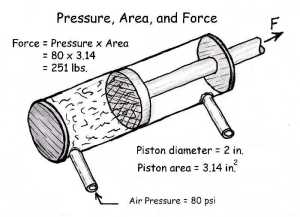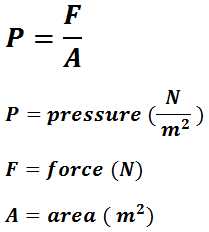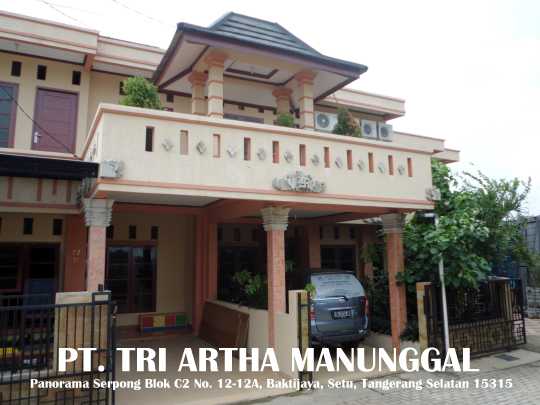


Pressure is force divided by area.
If you apply even a small force to a needle, the pressure at the tip is high because its area is small (look at the formula below). That is why it penetrates materials!
Pictured in the animation below, it transmits force from one piston (small) to the other (larger). The force is transmitted by a liquid (oil). A liquid exerts the same pressure in all directions (as well as a gas) and as a result the two pistons will exert different forces because of the different surface areas they possess, according to the formula P=F/A. (check out example below). The larger piston will travel a smaller distance but it will exert a larger force.
The hydraulic jack
The formula can be rearranged: P=F x A. Because the pressure (P) is the same in the whole system (which is the hydraulic jack), the force (F) will be larger where the area (A) of the piston is larger!
 This way it can lift a car, a lorry or anything... It is all about being able of building a large enough piston (engineering limitation).
This way it can lift a car, a lorry or anything... It is all about being able of building a large enough piston (engineering limitation).
The force exerted by the large piston will be larger than the force applied to the little piston, although the oil pressure is the same everywhere in the circuit.
If the area of the large piston is twice as big as the area of the little one, the force will be doubled. That is the point of this machine!
The small piston moves a longer distance while the large piston moves a shorter distance, as you wuld expect from the principle of the conservation of energy. You exert a small force but for a large distance; on the other end of the jack a large force is exerted by only for a short distance.It is a trade off. It is similar to the gear system of a bicycle: when you use a soft gear, which allows you to pedal easily, you have to pedal more times in order to cover the same distance.
In a modern hydraulic system, the force will be applied by a motor which pumps oil through the circuit. This is the principle of hydraulic machines, extensively used in the industry, especially in heavy machinery.
Car, train, lorry and aircraft control systems also make use of this technology.
Examples of questions and problems about Force and Pressure
1) A needle will exert enormous pressure because the surface area (A) of the point where the force (F) is being applied is very small. That's why it penetrates skin and other materials.
2) If your mass is 50 kg , what is the pressure you exert on the ground when you are standing up, assuming that the surface area of your shoes is 0.05 m2.
Answer:
(remember that mass is not the same as weight)
Assuming that g =10 m/s2 , F = 50kg x 10 m/s2 = 500 N (weight)
A = 0.05 m2
P = F / A = 500 N / 0.05 m2 = 10000 N / m2
3) A jack is projected to lift a bus which has a mass of 4 000 kg. If the large piston (the one that moves up in the animation) has an area of 1 m2 , and the small piston on the other end of the circuit has an area of 0.05 m2 , what is the minimum force that must be applied (to the little piston) in order to lift the bus?
Answer: We want find out a force, which is given by : F = P x A . P is the same in the whole circuit , and to do this exercise we don't need to know its value so that we will simply call it P.
Lets call the force on the small piston Fs and the force on the large piston FL . Likewise, the area of the small piston will be called A s and the area of the large piston A L. Because the pressure (P) is the same in both pistons we can write:
Fs = A s x P
and
FL = A Lx P
We know the areas ( A s = 0.05 m2and A L= 1 m2), so that we can substitute them in the equations:
Fs = 0.05 m2 x P
FL = 1 m2 x P
We have 2 equations and 2 unknowns. It is a system of equations. From now on you will use your maths skills. You could even pretend that you have x's and y's instead of F's , A's and P's , if it makes things easier to you.
There are many ways to solve this system . We will do it by dividing the top equation by the bottom one:
Fs / FL = 0.05 / 1
That is all (Remember that P / P = 1) .
So,
Fs / FL = 0.05
Rearranging:
Fs = 0.05 FL
In order to lift the bus , the force on the large piston (FL) must be al least 40 000 N (because the mass of the bus is 4 000 kg). So,
Fs = 0.05 x 40 000
Fs = 2 000 N (Final answer)
This example illustrates how a small force can be multiplied many times by using a hydraulic jack. This is the type of calculation that mechanical engineers do.

Comment :
Content of Comment :

DIRECTOR :
Mr. I Ketut Suada
Laboratory :
Panorama Serpong Blok C2 No. 12-12A, Baktijaya, Setu, Tangerang Selatan 15315
Telephone :
021-2930 8235
Website :
http//www.tri-artha.com
Email :
info@tri-artha.com
Representative Office :
Jl. PJHI Batakan No. 70A RT 15, Manggar, Kec. Balikpapan Timur, Kota Balikpapan, Kalimantan Timur 76116
BANKING :
BANK MANDIRI
BANK BCA
- Force & Pressure (9577062)
- Benefits of Calibration (512888)
- Definition Of Calibration (357717)
- Electricity (334331)
- Test Equipment Maintenance (273384)
- Dimension (232400)
- Temperature (113721)
.jpeg)

.jpeg)
.jpeg)

.jpeg)
.jpeg)
.jpeg)